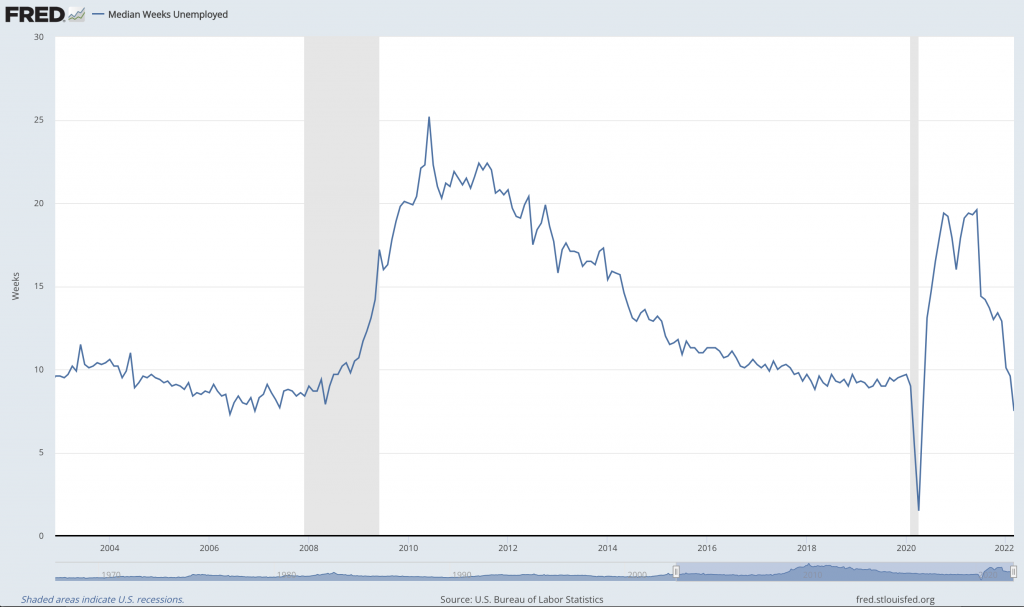Jeff Stein had a piece last week in which he asked various economists why they think the public has a negative view of the economy right now despite the fact that, by many measures, it is doing fairly well. In the piece, Jason Furman answered the question this way:
Many economists — including top Democratic ones — say this trend provides a simple explanation for voter anger. The job market recovery benefits roughly 6 million Americans who have been hired, whereas inflation hurts the roughly 150 million Americans who already had a job last year but are now getting poorer, said Jason Furman, who was a senior economist in the Obama administration.
Furman’s point is simple enough: the increases in hiring benefited a small number of people while the decreases in inflation-adjusted wages hurt a large number of people. But I think Furman’s argument here is actually weaker than it needs to be and the reason for this weakness is that his implied mental model of unemployment as affecting a specific, identifiable group of people who are out of work when times are bad but are brought into employment when times are good is not really how unemployment works.
When we say that 6 million people got a job last year, that is a net figure. What actually happened is that 20.3 million people lost a job at some point last year and 26.6 million people got a job at some point last year.
Even in good times, unemployment happens to tens of millions of people per year. Point-in-time net figures, such as the unemployment rate or payrolls, make it look like we are gradually draining the ranks of the unemployed. But those ranks are actually in a constant churn.
If you want to understand the real-life experience of unemployment for most people, it’s probably better to think about job-finding wait times than to think about specific numbers of unemployed people.
To see what I mean, imagine a society that has 100 million workers in the labor force. In this society, 3 million people lose their job each month and join the ranks of the unemployed. These 3 million people are able to find a new job after a month. Thus, the unemployment rate stands at 3 percent.
Now imagine this same society except that, instead of it taking one month to get re-employed, it takes two months to get re-employed. In this society, at any given time, the job-losers from this month and last month are in the ranks of the unemployed. Thus unemployment stands at 6 million people or 6 percent.
Both societies have the same number of people losing jobs each month (3 million) and the same number of people gaining jobs each month (3 million). What really differs between them is that the job-finding wait time in the first society is 4 weeks while the job-finding wait time in the second society is 8 weeks. Moving from society two to society one — i.e. adding 3 million net jobs and cutting unemployment in half — really just means cutting the job-finding wait time by 4 weeks.
Obviously this is a simplified model for the sake of illustration, but how long it takes to get re-employed after getting unemployed really is the main difference between high and low unemployment for your typical worker.

Once you understand unemployment this way, you realize that it is unlikely for direct experiences with unemployment to translate into political support. Last year, over 20 million people lost their jobs. Most of them got a new one within a couple of months, faster than they would have gotten a new one if not for the tight labor market, but their overall experience with the economy, especially as related to unemployment, was pretty bad.
I don’t know what exactly you do about this from a political perspective. It is generally good to pursue higher employment levels, but it’s not obvious how that will directly translate into political gains. It could indirectly translate into political gains, e.g. if the media provides a lot of praise that the public internalizes. But for any given individual, identifying whether they personally benefitted from the higher employment is nearly impossible, and even during higher employment, there is massive job churn.
From a policy perspective, my takeaway from this analysis is that the generosity of unemployment benefits matters much more than the precise level of employment, at least when it comes to the well-being of the unemployed. High employment means that unemployed people find jobs quicker, but it does not mean that only a handful of people experience unemployment. Thus to really solve the problem of unemployment, you should focus first on making sure that people are taken care of when it is their turn on the unemployment rolls.

